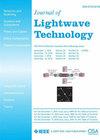湍流FSO信道上量子与经典信号传输共存的研究
IF 4.1
1区 工程技术
Q2 ENGINEERING, ELECTRICAL & ELECTRONIC
引用次数: 0
摘要
在当今世界,安全的数据传输是必不可少的,量子密钥分发(QKD)被广泛认为是实现信息论安全对称密钥生成的首选技术。虽然光纤通常被用作传输通道,但无线传输提供了到达地球每一个角落的灵活性;此外,对于地球-卫星QKD,无线通信自然成为必要。在本研究中,我们部署了一个光纤无线光学系统,该系统传输64-QAM 400 Gbps经典信号用于高速数据交换,传输1 MHz量子信号用于QKD。通过紊流自由空间信道传输单极化量子态和计算各自的本征量子误码率(QBER)来评估湍流对量子系统的影响。由此,我们估计了系统的密钥速率(SKR)及其对湍流的依赖关系。利用特制的大气室,模拟研究了大气湍流对光学无线信号的影响。大气室允许我们在0.06到2.52的雷托夫方差范围内改变湍流。经典信号显示,上述湍流状态的总体平均可靠性为82%。量子信号的结果表明,当Rytov方差高达1.3时,在测试条件下,密钥生成是可能的,在产生的湍流状态下,每个脉冲的最大SKR达到8.7$\mathbf{\ \乘以10^{-4}}$ bits。本文章由计算机程序翻译,如有差异,请以英文原文为准。
On the Coexistence of Quantum and Classical Signal Transmission Over Turbulent FSO Channels
Secure data transmission is essential in today's world, and quantum key distribution (QKD) is widely recognized as the technology of choice to enable information-theoretical secure symmetric key generation. While optical fibers are typically used as a transmission channel, wireless transmission offers the flexibility to reach every part of the Earth; moreover, for Earth-Satellite QKD, wireless communication naturally becomes a necessity. In this study, we deployed a fiber-wireless optical system that transmitted a 64-QAM 400 Gbps classical signal for high-rate data exchange and a 1 MHz quantum signal for QKD. The impact of turbulence in the quantum system is evaluated by transmitting single-polarization quantum states through a turbulent free-space channel and by calculating the respective intrinsic quantum bit error rate (QBER). From this, we estimate the system's secret key rate (SKR) and its dependence on turbulence. The effects of atmospheric turbulence on the optical wireless signal were emulated and investigated by using a custom-made atmospheric chamber to induce different turbulent scenarios. The atmospheric chamber allowed us to vary the turbulence in a Rytov variance range from 0.06 to 2.52. The classical signal showed an overall average reliability of 82% for the mentioned turbulence regimes. The results of the quantum signal showed that for Rytov variances up to 1.3, and under the conditions tested, secret key generation is possible, reaching a maximum SKR of 8.7$\mathbf {\times 10^{-4}}$
求助全文
通过发布文献求助,成功后即可免费获取论文全文。
去求助
来源期刊

Journal of Lightwave Technology
工程技术-工程:电子与电气
CiteScore
9.40
自引率
14.90%
发文量
936
审稿时长
3.9 months
期刊介绍:
The Journal of Lightwave Technology is comprised of original contributions, both regular papers and letters, covering work in all aspects of optical guided-wave science, technology, and engineering. Manuscripts are solicited which report original theoretical and/or experimental results which advance the technological base of guided-wave technology. Tutorial and review papers are by invitation only. Topics of interest include the following: fiber and cable technologies, active and passive guided-wave componentry (light sources, detectors, repeaters, switches, fiber sensors, etc.); integrated optics and optoelectronics; and systems, subsystems, new applications and unique field trials. System oriented manuscripts should be concerned with systems which perform a function not previously available, out-perform previously established systems, or represent enhancements in the state of the art in general.
 求助内容:
求助内容: 应助结果提醒方式:
应助结果提醒方式:


